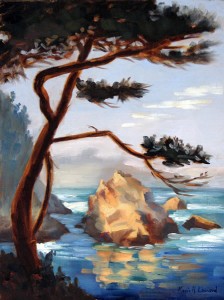” I would like to paint the way a bird sings.” (Claude Monet)
 1. “Plein-what…?”
1. “Plein-what…?”
In the 18oos, tube paints became available, and with them, it became possible to “take the studio outside.” Claude Monet and the Impressionist painters popularized painting “en-plein air” (French for outside), a mode of painting that before then was at most considered preliminary sketching for studio works.
WIth the Impressionists, painting outside became an art form in itself. Working under natural, quickly changing light brings freshness, true color and immediacy to the canvas studio work simply can’t provide.
Today, many landscape painters paint both en-plein-air and in the studio ~ these approaches are like the two sides of a coin: painting outside provides the much needed “reality” check of being on location ~ not only color, light and composition, but also the gathering of information through all senses as well as the “energetic read” we get about the soul and spirit of a place. Studio work, when you can paint without quickly changes light and weather conditions, gives you the time to go deep with your subject, and helps to integrate all you have learned on location. Many painters use the typically smaller plein air works, reference photos and their memories of being on location to create larger studio works.
2. How do you…?
Ready to paint outside? I can tell you, it is one of the most thrilling experiences life offers. And I won’t claim that it is easy, especially at first. I remember my first experience painting en plein air very well, I was ready to throw in the towel after that, or should I say the easle and everything that goes with it! But something kept me going back ~ again and again. Plein-air painting is still not a walk in the park (ha ha), and there have been times of tears and near break-downs, when “plein air” painting became “complainer” painting. Hower, to many of us crazies painting outside is a spiritual experience ~ you can’t get any closer to the heart of nature than in her own temple!
So if you have even the faintest sense of adventure, I say give plein air a go. Probably the best intoduction is to take a workshop, and learn the ropes. This is where an experienced teacher can really help. And going out to paint with a group is wonderful ~ you’ll have comraderie, learning from each other and the safety of being with others. Locally we are blessed with a wonderful group of painters, and there may well be one in your area. Give Mr Google a try! And if there are no groups in your vicinity, you might consider starting one…
3. So what do I need…?
 The basics of painting outside are a portable “plein-air” Easel, your paints and paraphenelia. There are many easles on the market now, none of them perfect (invention, anyone…? There is room for THE plein air easel). Plus you’ll want to bring all the little comforts for being in nature like hats, sunscreen, bugspray and sustenance like lunch, snacks and water.
The basics of painting outside are a portable “plein-air” Easel, your paints and paraphenelia. There are many easles on the market now, none of them perfect (invention, anyone…? There is room for THE plein air easel). Plus you’ll want to bring all the little comforts for being in nature like hats, sunscreen, bugspray and sustenance like lunch, snacks and water.
Portable is key, especially if you are going more than a few steps from your car. Also consider painting in the shade whenever possible, the sun throws off your color sense and can fry you into a crisp.
For a checklist of what to take on your plein-air painting excursion, and many tips on this art form, please visit PleinAirMuse.com .You will find this website full of great resources for painting outside, including worldwide painting location suggestions.

